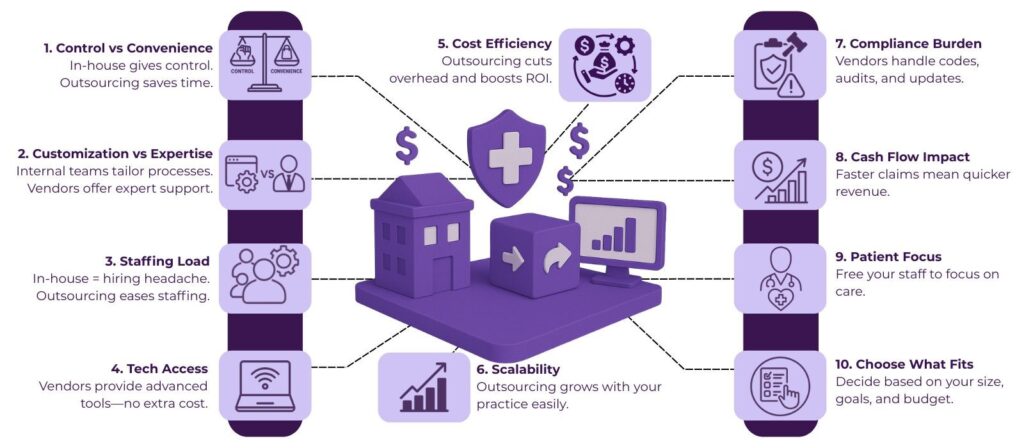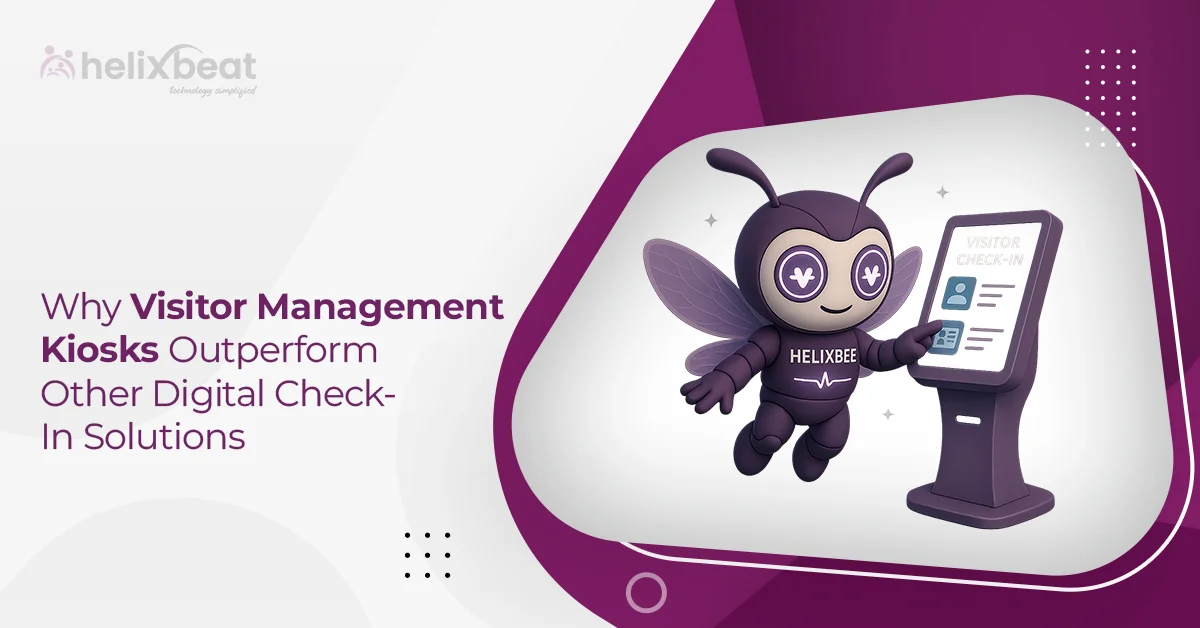Running a healthcare practice today means wearing more hats than ever before. One moment you’re focused on patient care, the next you’re navigating a maze of billing rules, insurance policies, and claim denials. The pressure is real—staff burnout, missed reimbursements, and rising administrative costs all stem from one critical area: Revenue Cycle Management (RCM).
For many providers, managing RCM in-house feels like trying to plug leaks in a sinking ship. Just when one issue is resolved, another pops up. Others are exploring a different path—outsourcing revenue cycle management to specialized partners who bring in systems, automation, and expertise to do the heavy lifting.
But is outsourcing the right move for your practice? Or does keeping it in-house offer more control and confidence?
This blog breaks down both options, highlighting the pros, cons, and what healthcare providers need to consider before making the call. Because the health of your revenue is just as important as your patients.

Table of Contents
Understanding Revenue Cycle Management Options
Revenue cycle management encompasses all administrative and clinical functions related to the capture, management, and collection of patient service revenue. This includes patient registration, insurance verification, billing, coding, claims processing, denial management, and reimbursement.
There are two main ways to manage RCM:
- In-House RCM: Healthcare providers perform all RCM functions internally using their own staff, software, and systems.
- Outsourcing Revenue Cycle Management: The healthcare organization partners with an external company like HelixBeat, which offers end-to-end management of the revenue cycle using advanced technology, domain expertise, and automation tools.
Complications Faced by Healthcare Providers When Choosing RCM Options
Healthcare administrators often struggle with:
- Lack of in-house expertise
- Rising labor costs and staffing shortages
- Increased billing errors and claim denials
- Changing compliance regulations
- Sluggish reimbursements and revenue leaks
Choosing the right RCM strategy—internal or external—can impact everything from revenue flow and compliance to patient satisfaction and operational efficiency.
Pros of In-House Revenue Cycle Management
1. Control and Oversight:
Healthcare providers have full visibility over the entire revenue cycle. This enables quick decision-making, real-time adjustments, and closer monitoring of performance metrics.
2. Customization:
Processes and workflows can be customized to match specific departmental needs, clinical practices, and internal goals, allowing a more personalized approach to revenue cycle handling
3. Data Security:
All patient and financial data remains within the organization’s systems, reducing exposure to third-party risks and allowing tighter compliance with data protection policies.
4. Seamless Communication:
Internal billing and administrative teams can directly collaborate with clinical staff, minimizing miscommunication and speeding up issue resolution.
5. Cultural Alignment:
In-house teams often better understand the practice’s values, culture, and patient approach, leading to more cohesive workflows and patient-first communication.
Cons of In-House Revenue Cycle Management
1. Resource Intensive: Maintaining an in-house team demands constant investments in recruitment, training, certifications, payroll, and upgrading technology.
2. Limited Scalability: Internal systems may struggle to keep up with growing patient volumes, multi-location practices, or evolving payer requirements without substantial reinvestment.
3. Risk of Errors: Manual coding and billing, especially without AI or automation tools, increases the chances of human error, claim denials, and delayed reimbursements.
4. Regulatory Burden: Keeping up with ever-changing coding standards (like ICD, CPT, HCPCS), payer rules, and healthcare regulations requires ongoing education and time.
5. Delayed Innovations: Internal teams may lack access to the latest RCM technologies or analytics platforms, limiting opportunities for performance optimization and cost reduction.
6. Employee Turnover Impact: Billing staff turnover can disrupt operations and lead to knowledge gaps, re-training costs, and workflow inefficiencies.
7. High Operational Costs: From salaries and software licenses to compliance tools and hardware, maintaining an in-house RCM setup can become a significant financial burden.
Pros of Outsourcing Revenue Cycle Management
1. Specialized Expertise: HelixBeat offers a dedicated team of RCM professionals with deep knowledge of complex billing codes, payer regulations, and compliance requirements, helping avoid costly errors.
2. AI-Powered Accuracy and Efficiency: Leveraging advanced automation and AI-driven tools, HelixBeat reduces manual errors, speeds up claims processing, and improves denial management, ensuring faster reimbursements.
3. Cost Savings: Outsourcing revenue cycle management can eliminate the need to maintain a large in-house billing staff. It is like investing in expensive software upgrades and continuously training employees, leading to significant operational cost reductions.
4. Revenue Optimization: Streamlined workflows, proactive follow-ups, and expert denial management maximize revenue capture and improve cash flow stability for healthcare organizations.
5. Focus on Patient Care: By delegating administrative and billing complexities to HelixBeat, providers can focus their time and resources on delivering quality patient care.
6. Scalability and Flexibility: HelixBeat can easily scale services up or down based on patient volume fluctuations or regulatory changes without disrupting daily operations.
7. Access to Latest Technology: Outsourcing revenue cycle management partners like HelixBeat continually invest in cutting-edge RCM software and analytics platforms, providing clients with ongoing improvements without extra effort.
8. Enhanced Compliance: HelixBeat stays updated with evolving healthcare regulations (HIPAA, payer policies, coding standards) ensuring your practice avoids penalties and maintains regulatory compliance.
9. Comprehensive Reporting and Analytics: Detailed real-time dashboards and customizable reports provide transparency into revenue cycles, enabling data-driven decisions.
Cons of Outsourcing Revenue Cycle Management
1. Loss of Some Control: Outsourcing revenue cycle management may lead to reduced direct oversight of day-to-day billing activities, requiring robust reporting and communication channels to maintain transparency.
2. Integration Challenges: Migrating from in-house systems to an outsourced model demands careful IT alignment, workflow adjustments, and staff retraining to minimize operational disruptions.
3. Vendor Dependency: Relying heavily on an external provider means entrusting critical financial processes to a third party, which makes choosing the right vendor and setting performance-based SLAs vital.
4. Potential Quality Variability:
Service quality can vary between vendors; inconsistent performance may affect revenue cycle outcomes and patient satisfaction if not properly managed.
5. Data Security Concerns: Sharing sensitive patient and financial information with a third party introduces risks that must be mitigated through strict data protection protocols and compliance standards.
6. Transition Period Delays: Initial onboarding and transition phases may temporarily slow down revenue cycle processes until full integration and staff adaptation occur.
7. Communication Barriers: Working with an external team might introduce delays or misunderstandings unless communication channels are clearly established and maintained.
HelixBeat enables organizations to reduce administrative burdens while increasing accuracy and profitability.
Key Considerations for Healthcare Organizations
When deciding whether to manage RCM internally or explore revenue cycle management outsourcing, consider the following:
- Practice Size and Volume: High-volume practices often benefit from outsourcing due to scalability and cost savings.
- Complexity of Services: Multi-specialty or high-acuity practices may require specialized coders that an external partner can provide.
- Budget Constraints: Outsourcing revenue cycle management can reduce overhead and capital expenditure.
- Technology Capabilities: If you lack integrated billing and analytics tools, a third-party RCM provider can fill the gap.
- Compliance Risk: An experienced RCM partner ensures adherence to industry regulations.
- Time to Focus on Patients: Outsourcing revenue cycle management can free up internal teams to focus on care delivery rather than administrative work.
Tips for Selecting an Outsourcing Revenue Cycle Management Partner
If you decide that outsourcing revenue cycle management is the right move for your healthcare practice, choosing the right partner is critical. Here are essential tips to guide your selection:
1. Evaluate Industry Experience
Choose a partner like Helixbeat with a strong track record in your specialty. Ask for client references and case studies.
2. Check Certifications
Ensure the team includes certified coders (e.g., CPC, CCS) and billing experts trained in current regulations.
3. Assess Technology & Reporting Tools
Look for providers offering transparent, real-time reporting dashboards and secure communication tools.
4. Understand SLAs and KPIs
Review service level agreements that define turnaround time, accuracy rates, denial handling, and A/R targets.
5. Compliance and Data Security
Ensure your partner follows HIPAA guidelines, uses secure platforms, and conducts regular audits.
6. Ask About Customization
Your partner should offer flexible RCM solutions tailored to your needs—not a one-size-fits-all approach.
7. Review Cost Structures
Understand how the pricing model works—percentage of collections, per-claim rate, or subscription—and confirm there are no hidden fees.
8. Pilot Before Full Rollout
Start with a trial or partial outsourcing model to assess the provider’s performance before committing long-term.
9. Choose a Collaborative Team
HelixBeat’s dedicated account managers and support specialists make transitions smoother and operations consistent.
Elevate Your Revenue with HelixBeat
HelixBeat empowers healthcare organizations to:
- Automate and accelerate billing
- Minimize errors and delays
- Increase revenue collection
- Gain data-driven insights
- Focus more on clinical care than administrative overhead
As a leader in Revenue Cycle Management Outsourcing, HelixBeat is designed for modern healthcare practices looking to streamline operations without compromising control or quality.
Conclusion
Managing RCM is no longer just an operational decision—it’s a strategic one. For many healthcare organizations, the choice between in-house RCM and Outsourcing Revenue Cycle Management determines how efficiently they can sustain financial stability while delivering top-notch care.
While in-house RCM offers more control and customization, it requires substantial investment and ongoing management. On the other hand, revenue cycle management outsourcing to experts like HelixBeat provides access to superior technology, industry expertise, and scalable support systems—making it an increasingly attractive option.
Ultimately, the best choice depends on your organization’s goals, resources, and need for flexibility. By partnering with a trusted outsourcing vendor like HelixBeat, healthcare providers can unlock higher revenue, ensure regulatory compliance, and dedicate more time to what truly matters—patient care.
People also asking
1. What are the primary benefits of outsourcing revenue cycle management (RCM) services for healthcare providers?
Outsourcing Revenue Cycle Management services allows healthcare providers to streamline billing operations, reduce errors, and ensure faster reimbursements. Key benefits include access to expert coders, automation tools, reduced administrative burden, cost savings, improved compliance, and more time to focus on patient care. It also provides scalability and transparency through advanced analytics and reporting.
2. Why should I outsource RCM services for my medical practice?
Outsourcing RCM services can significantly reduce the operational strain on your in-house staff. It eliminates the need for continuous training, technology upgrades, and compliance monitoring. By partnering with a specialized RCM provider like HelixBeat, you gain access to experienced professionals, AI-powered tools, and a scalable system that optimizes cash flow and enhances overall practice performance.
3. How can RCM audit solutions improve the financial health of a struggling medical practice?
RCM audits help identify revenue leaks, coding errors, claim denial trends, and inefficiencies in billing workflows. By uncovering these problem areas, a detailed audit can guide corrective actions that improve cash flow, reduce AR days, ensure regulatory compliance, and enhance financial performance. It acts as a roadmap to regain financial stability and optimize reimbursement cycles.
4. What steps are you taking to improve the financial health of your medical practice?
To improve financial health, many practices are:
- Evaluating in-house vs outsourcing RCM models
- Implementing automated billing systems
- Reducing claim denials through expert coding
- Monitoring KPIs like AR days, first-pass resolution rate, and clean claims rate
- Partnering with experienced RCM providers like HelixBeat to optimize operations and reduce costs
5. How can outsourcing revenue cycle management services improve the financial health of medical practices?
Outsourcing RCM improves financial health by ensuring accurate coding, faster claim processing, and effective denial management. It reduces overhead costs and minimizes revenue loss through expert oversight and automation. Practices experience improved cash flow, reduced billing errors, enhanced compliance, and more predictable revenue streams.
6. What are the advantages of outsourcing revenue cycle management for healthcare practices?
Key advantages of outsourcing RCM include:
- Specialized expertise in coding and payer rules
- Reduced operational and staffing costs
- Faster and more accurate claim submissions
- Access to the latest RCM technology
- Enhanced compliance and data security
- Scalable support for growing practices
- Better insights through real-time reporting and dashboards














